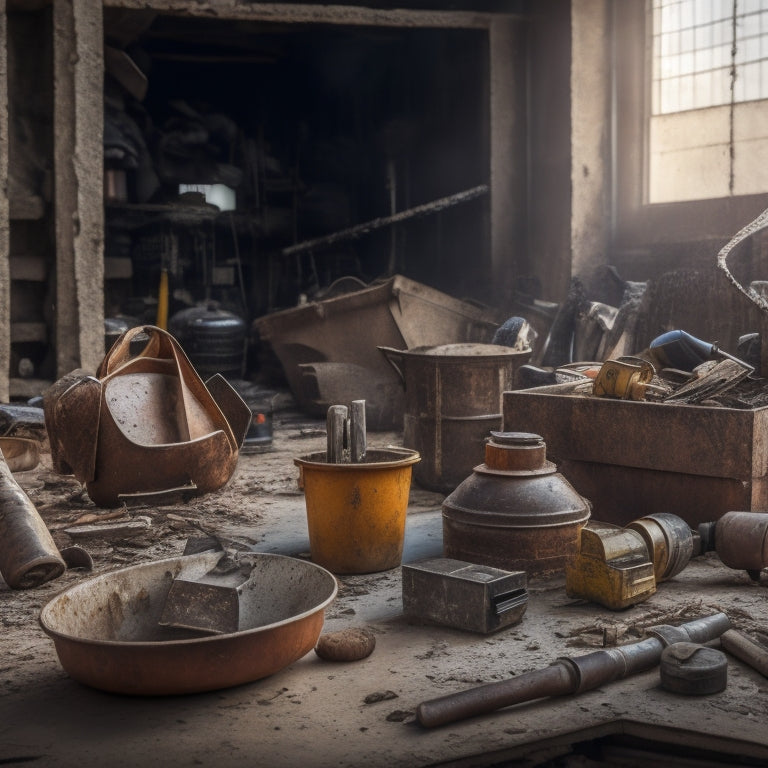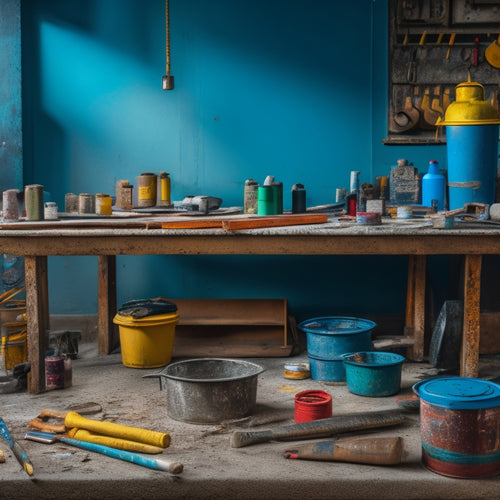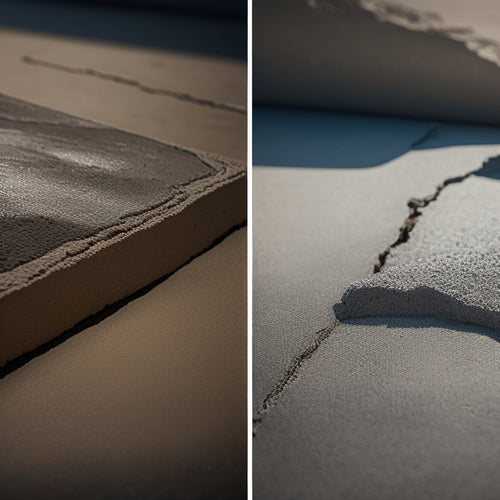
Why Choose the Right Concrete Tools at Right Time
Share
You invest a significant amount of time and resources into a concrete project, but using the wrong tools at the wrong time can lead to costly delays, rework, and even compromise the structural integrity of the final product. Choosing the right concrete tools at the right time guarantees a solid foundation, prevents mistakes, and optimizes efficiency. It saves you money by minimizing waste, reducing labor hours, and avoiding equipment downtime. By selecting high-quality tools that fit your project's specific needs, you'll achieve a durable, aesthetically pleasing, and safe final product. Now, let's explore the key phases where tool selection makes all the difference.
Key Takeaways
• The right concrete tools ensure accurate measurements, precise cuts, and proper finishing techniques, resulting in a durable and aesthetically pleasing surface.
• High-quality tools withstand heavy use and harsh conditions, minimizing replacements and reducing project costs.
• Ergonomic design and compatibility with specific materials and surfaces reduce fatigue, discomfort, and costly mistakes.
• The right tools facilitate efficient work, reducing labor hours and material waste, and preventing project delays and cost overruns.
• Choosing the right concrete tools at the right time guarantees a solid foundation, prevents structural failures, and ensures a successful project outcome.
Planning and Budgeting Phase
Before diving into a concrete project, set a realistic budget and timeline by identifying the necessary concrete tools and their costs, and prioritizing your needs based on the project's scope and complexity. This step is essential to guarantee you have the right tools for the job, avoid costly delays, and maintain a safe working environment.
When it comes to budgeting strategies, consider the costs of purchasing versus renting concrete tools. Tool rental can be a cost-effective option, especially for specialized equipment you may only need for a short period. Research local rental companies and compare prices to find the best deals.
Additionally, factor in the costs of maintenance, fuel, and operator training when calculating your overall budget. By taking the time to plan and budget, you'll be better equipped to tackle your concrete project efficiently and effectively, while minimizing risks and guaranteeing a successful outcome.
Site Preparation and Demolition
When you're preparing a site for concrete work, you'll need to tackle three essential tasks: clearing the area of debris, demolishing any existing structures, and preparing the ground for construction.
You'll want to start by removing any obstacles, such as rocks or old materials, to guarantee a safe and even work surface.
Clear the Debris Away
You'll need to thoroughly clear the site of any debris, obstructions, and hazardous materials to guarantee a safe and efficient concrete project. This step is vital in preventing accidents and ensuring a successful outcome. Debris removal is a significant aspect of site preparation, and it's important to use the right clean up methods to get the job done effectively.
Here are some common debris removal methods and tools you may need:
| Debris Type | Removal Method | Tools Required |
|---|---|---|
| Construction waste | Hand sorting and disposal | Gloves, trash bags, dumpsters |
| Heavy materials | Mechanical lifting and removal | Cranes, forklifts, dollies |
| Hazardous materials | Specialized disposal and containment | Hazmat suits, containers, gloves |
| Vegetation | Cutting and removal | Chainsaws, pruning saws, loppers |
| Loose rubble | Sweeping and vacuuming | Brooms, dustpans, vacuum trucks |
Remember to always follow safety protocols and regulations when clearing the site, and consider hiring professionals if you're unsure about how to handle certain types of debris. By taking the time to thoroughly clear the site, you'll be able to move forward with your concrete project with confidence.
Demolish Existing Structures
With the site cleared of debris, you're now ready to demolish any existing structures that will interfere with your concrete project, using the right tools and techniques to confirm a safe and efficient process.
Demolition can be a hazardous task if not done correctly. That's why it's vital to take necessary safety precautions and employ proper demolition techniques.
Here are some essential considerations to keep in mind:
-
Wear protective gear: Make sure you and your team wear hard hats, safety glasses, gloves, and dust masks to minimize exposure to hazardous materials and debris.
-
Use appropriate demolition tools: Select the right tools for the job, such as hydraulic breakers, jackhammers, or wrecking balls, depending on the type and size of the structure.
-
Control the demolition process: Plan and execute the demolition sequence carefully to avoid unwanted collapses or damage to surrounding structures.
Prepare the Ground
How do you guarantee the ground is stable and ready for your concrete project after demolition, considering the site's unique conditions and potential hazards? You must verify the ground is properly prepared to avoid costly delays and safety risks.
Start by clearing the site of debris and obstructions.
Next, conduct soil testing to determine the soil's composition and density. This vital step helps you identify potential issues with ground stability and allows you to develop a plan to mitigate them.
You may need to compact the soil or install reinforcements like piers or anchors to guarantee the ground can support the weight of your concrete structure.
Additionally, inspect the site for any underground utilities or obstacles that could impact your project.
By taking these steps, you'll be able to identify and address any potential hazards, guaranteeing a safe and successful concrete project.
Foundation and Slab Work
When building foundations and slabs, accurately laying out the site and preparing the subgrade are essential initial steps that directly impact the entire project's structural integrity.
You must guarantee the site is level, compacted, and cleared of debris to prevent settlement issues and ensure a strong bond between the concrete and subgrade.
To achieve a solid foundation, consider the following key factors:
-
Concrete types: Select the appropriate concrete type for your project, such as high-strength, fiber-reinforced, or self-consolidating concrete, depending on the specific requirements and conditions.
-
Reinforcement methods: Choose the right reinforcement method, including rebar, fiber mesh, or post-tensioning, to provide the necessary strength and durability for your foundation or slab.
-
Subgrade preparation: Ensure the subgrade is properly compacted and prepared to prevent settlement and guarantee a stable base for your concrete foundation or slab.
Wall Framing and Installation
When you're working on wall framing and installation, you'll need to guarantee accurate measurements and precise stud alignment.
A framing square is an essential tool for this task, as it helps you verify squareness and make adjustments as needed.
Framing Square Importance
You rely on a framing square to confirm accurate angles and precise measurements during wall framing and installation, as it serves as a reference point for checking and marking cuts, studs, and joists.
This essential tool guarantees that your walls are square, plumb, and level, which is vital for the structural integrity of the building. Without a framing square, you risk compromising the safety and stability of the structure.
Here are three key reasons why a framing square is essential for wall framing and installation:
-
Accurate measurements: A framing square helps you take precise measurements, confirming that your cuts and joints fit together perfectly.
-
Framing square applications: From checking the squareness of walls to marking studs and joists, a framing square is an indispensable tool for various framing tasks.
-
Framing square accuracy: By providing a reliable reference point, a framing square confirms that your work is accurate and consistent, reducing the risk of errors and mistakes.
Proper Stud Alignment
In wall framing and installation, guaranteeing proper stud alignment is critical to maintaining the structural integrity of the building, as it directly affects the load-carrying capacity of the walls.
You must understand that misaligned studs can lead to weakened walls, compromising the overall safety of the structure. To avoid this, you should familiarize yourself with effective stud alignment techniques.
One common technique involves using a laser level to project a level line along the wall, guaranteeing that studs are installed plumb and straight. Another technique involves using a framing square to check the alignment of studs at regular intervals.
When it comes to common alignment mistakes, you should watch out for studs that aren't installed at 16-inch on-center intervals, as well as studs that aren't properly secured to the top and bottom plates.
Finishing and Detail Work
Finishing and detail work require a range of specialized tools to achieve a smooth, even surface and precise edges. As you move forward with your concrete project, you'll need to switch to more precise finishing techniques that demand attention to detail. This is where the right detail tools come into play.
Here are three essential tools you'll need for finishing and detail work:
-
Floats and trowels: These tools help you achieve a smooth, even surface by removing excess concrete and filling in gaps.
-
Edgers and jointers: These tools enable you to create clean, precise edges and joints, giving your concrete a professional finish.
-
Grinding and polishing tools: These tools allow you to refine your concrete's surface, removing imperfections and achieving a high-gloss finish.
When choosing your finishing and detail tools, prioritize safety and quality. Look for tools with ergonomic handles, durable materials, and adjustable settings to guarantee you can work efficiently and accurately.
Final Inspections and Touch-ups
As the concrete project nears completion, a thorough final inspection is essential to identify any imperfections or defects that require touch-ups.
You'll want to conduct a final walkthrough to guarantee that every aspect of the project meets the required standards. This includes checking for any cracks, uneven surfaces, or other defects that could compromise the structural integrity or aesthetic appeal of the concrete.
During the final inspection, you'll be verifying that all quality assurance protocols have been followed.
This involves reviewing the project's documentation, including records of materials, equipment, and labor used. You'll also be checking that all necessary tests and inspections have been conducted, and that the results meet the specified requirements.
Tool Selection for Foundation Work
Select the right tools for foundation work to guarantee a solid base for your concrete project, and avoid costly rework or even structural failure down the line. You can't afford to compromise on the quality of your tools when it comes to foundation work, as it's the backbone of your entire project.
When selecting tools for foundation work, consider the following key factors:
-
Tool durability: Look for tools made from high-quality materials that can withstand the rigors of heavy use and harsh environmental conditions. Durable tools will reduce the need for frequent replacements, saving you time and money.
-
Ergonomic design: Choose tools that are designed with ergonomics in mind. This will help reduce fatigue and discomfort, allowing you to work more efficiently and safely.
-
Compatibility: Verify that your tools are compatible with the specific materials and surfaces you're working with. This will help you achieve the best possible results and avoid costly mistakes.
Preventing Delays and Cost Overruns
Preventing Delays and Cost Overruns
By choosing the right tools for foundation work, you've taken a significant step towards preventing delays and cost overruns in your concrete project. Effective project management and resource allocation are essential to ensuring your project stays on track and within budget. The right tools can help you avoid common pitfalls that can derail your project, such as equipment downtime, labor inefficiencies, and material waste.
| Tool | Benefits | Impact on Project |
|---|---|---|
| High-quality concrete mixers | Faster mixing times, improved consistency | Reduced labor hours, increased productivity |
| Precise leveling tools | Accurate surface preparation, reduced rework | Minimized delays, improved quality |
| Durable finishing equipment | Efficient finishing processes, reduced wear and tear | Extended equipment lifespan, reduced maintenance costs |
Frequently Asked Questions
How Often Should I Clean and Maintain My Concrete Tools?
You should clean and maintain your concrete tools regularly to guarantee their longevity and performance.
Aim for a daily cleaning frequency, wiping down tools with a damp cloth to remove dirt and debris.
For deeper maintenance, set aside time weekly to inspect and repair tools, and perform thorough cleaning every month.
Following these maintenance tips will help prevent damage, reduce wear and tear, and guarantee your tools are always in good working condition.
Can I Use a Hammer for All Concrete Demolition Tasks?
You can't use just any hammer for all concrete demolition tasks. Different hammer types, like claw hammers, sledgehammers, and demolition hammers, are suited for specific demolition techniques.
For instance, a claw hammer is ideal for small-scale demolition, while a sledgehammer is better for large-scale projects.
Using the wrong hammer can lead to inefficient work, damage to surrounding structures, and even injury.
Always choose the right hammer for the task at hand to guarantee safety and effectiveness.
What Safety Gear Is Necessary for Concrete Finishing Work?
When you're working on concrete finishing tasks, you're exposed to hazards like dust, debris, and chemicals. You need to prioritize concrete safety.
Wear protective gear like safety glasses, gloves, and a dust mask to prevent injuries. Additionally, invest in knee pads, steel-toed boots, and a hard hat to guarantee your overall well-being.
Mastering finishing techniques requires attention to detail and a focus on safety - don't compromise on either.
Are Concrete Mixing Buckets Suitable for All Mixing Tasks?
When it comes to mixing concrete, you'll find that not all buckets are created equal.
Different mixing bucket types serve specific purposes, and choosing the right one can greatly impact mixing efficiency.
For instance, a heavy-duty bucket with a sturdy handle is ideal for large pours, while a smaller, lighter bucket is better suited for smaller batches.
You'll want to select a bucket that fits your specific mixing needs to guarantee a smooth, efficient process.
Can I Reuse Concrete Finishing Trowels Multiple Times?
'You're probably thinking, 'Back in ancient Egypt, they built pyramids with reused tools, why can't I?'
But, when it comes to concrete finishing trowels, it's not that simple. You can reuse them, but only if you properly care for them.
Different trowel types, like steel, resin, or polyurethane, have specific care requirements. Clean and store them correctly to guarantee they remain effective and safe to use multiple times.
Don't risk compromising your project's quality or your safety – take the time to maintain your trowels.'
Conclusion
As you finally emerge from the trenches, battered and bruised, you'll realize that choosing the right concrete tools at the right time was the difference between sanity and utter chaos.
Without them, your project would've resembled a war zone, with delays and cost overruns raining down like bombs.
But with the right tools, you've managed to contain the madness, barely.
Congratulations, you've survived the concrete jungle.
Now, go forth and bill your client.
Related Posts
-

Essential Tools for Painting Concrete Walls
When painting concrete walls, you'll need a range of specialized tools to achieve a professional-looking finish. Star...
-

Best Tools for Concrete Restoration and Repair
When tackling concrete restoration and repair projects, you need a range of reliable tools to achieve professional-gr...
-

What Tools Ensure Strong Concrete Adhesion at Home
You'll need the right tools to guarantee strong concrete adhesion at home. For surface preparation, use concrete surf...


